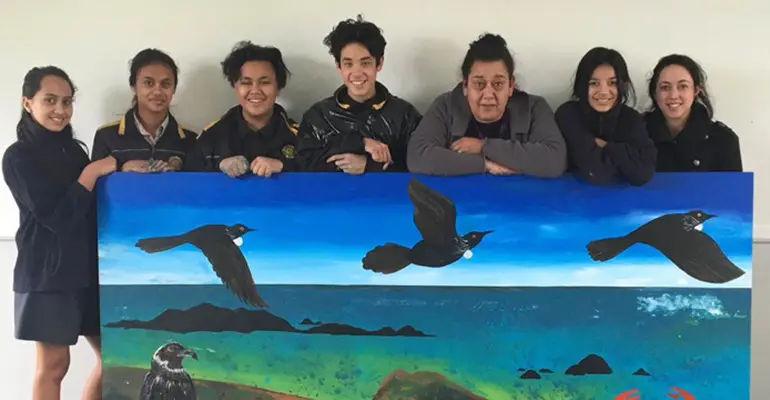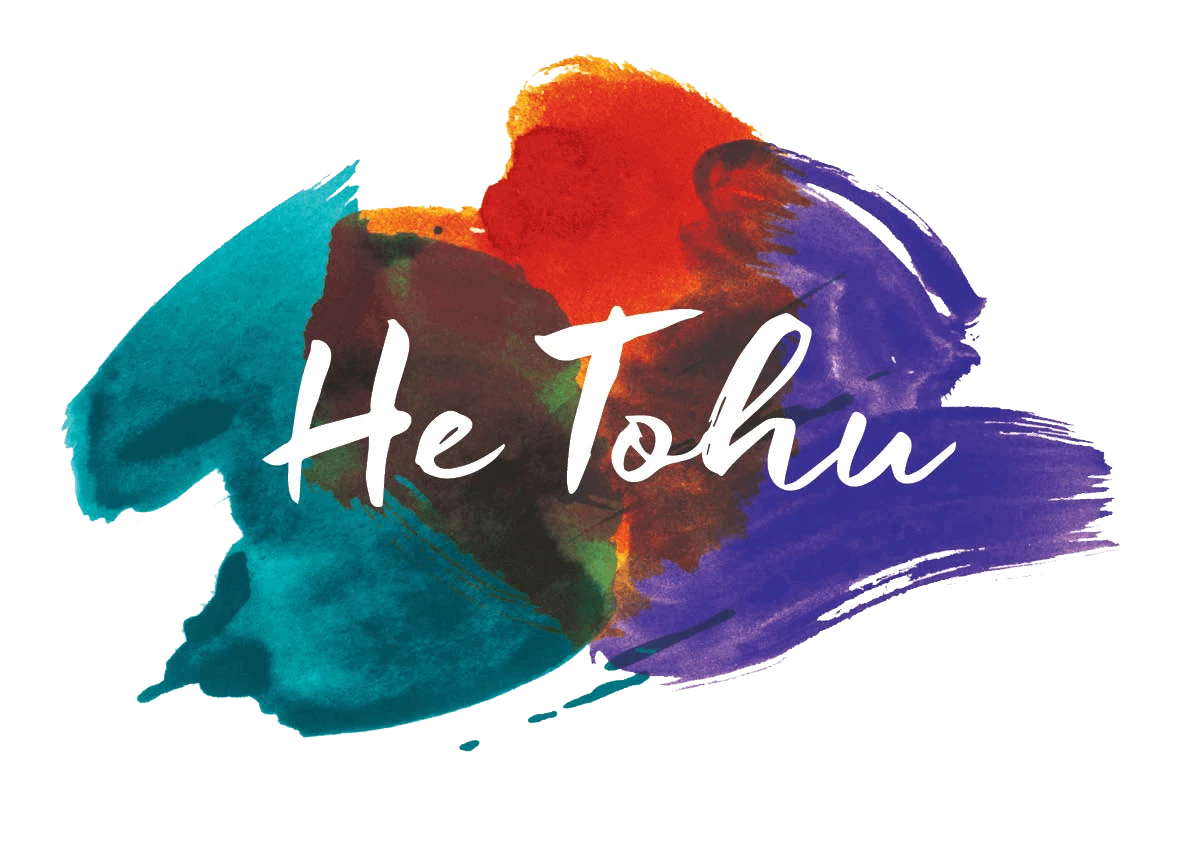The process of development

All rights reserved
Read how these te reo Māori learning resources came to be, what they contain, and how to create your own.
Me ako ā tātou tamariki
Me ako ā tātou tamariki, he kawenata Te Tiriti o Waitangi. Ko ōna pūtaketake, he rangatiratanga, he tohungatanga, he manaakitanga, he whanaungatanga, he ūkaipō. Otirā, kei tua ko te aka matua, tōna ingoa ko te Kotahitanga.
We should teach our children that Te Tiriti o Waitangi is a sacred covenant. Its roots are self-determination, expertise, service to others, positive relationships and places of the heart. But beyond and encompassing all these is the tap-root, its name is Unity.
— Nō te Tai Tokerau tēnei kōrero, tēnei whakahau.
He Tohu – learning resources
He Tohu, at the National Library Te Puna Matauranga, aims to inspire young people to know more about the foundations of our country.
These learning resources support young te reo speakers in learning more about He Whakaputanga, Te Tiriti o Waitangi, and the Women’s Suffrage Petition.
Both He Whakaputanga and Te Tiriti o Waitangi were first produced in the north. It is therefore fitting that the request was put to the north to work with the National Library to develop learning resources in te reo Māori.
Te Kura Kaupapa Māori o Whangaroa answered the request, and the whānau and teachers of the kura crafted materials that told their history. These learning resources were created to start embedding He Whakaputanga and Te Tiriti o Waitangi into the curriculum of the kura.
They now provide these resources to He Tohu and to you. They are offered as guidance as you approach these topics with your students.
Cultural narrative
These resources come out of a particular iwi and hapū perspective informed by the experiences of the people of Whangaroa. Every hapū, every iwi has their own perspectives, their own histories. Every hapū, every iwi is entitled to tell their perspective, to tell their history to their children.
This approach uses local content to provide meaningful experiences that reinforce the student’s language, culture and identity.
From the perspective of Te Kura Kaupapa Māori o Whangaroa, it is appropriate to start with the world of the child. Feed the child’s mind with appropriate ‘food’ and in their own time they will understand.
Te Kura Kaupapa Māori o Whangaroa
Whangaroa is an area bound by the Oruaiti river to the north and the Takou river to the south along the east coast of Northland. Te Kura Kaupapa Māori o Whangaroa is situated at Matauri Bay. It is a composite school that follows Te Aho Matua o ngā kura kaupapa Māori as the educational philosophy.
Te Kura Kaupapa Māori o Whangaroa offers these learning resources to other schools with humility and compassion for our language. We should also remember our ancestors’ experiences so we learn from the past and generations to come can move forward with optimism.
The Charter
Development of these resources began with an analysis of the kura’s Charter, which contains the school’s goals and plans to raise student achievement.
The Charter of Te Kura Kaupapa Māori o Whangaroa states:
We have faith and trust in the words and principles expressed in Te Tiriti o Waitangi as a sacred covenant that gives authority to the position of the kura as a symbol of tino rangatiratanga of Māori and of non-Māori.
We must teach our children that Te Tiriti o Waitangi is a sacred covenant (that arose out of Te Whakaputanga o te Whakaminenga).
The whānau of the kura must seek understanding of Te Whakaputanga, Te Tiriti o Waitangi and the relevance of those taonga to the kura.
It also contains the long term, 3-year curriculum plan and the intention to develop a curriculum called Whangaroatanga.
The community working together
The kura held a number of hui over 6 months. All whānau were invited to the first hui, an opportunity to gather thoughts and ideas about the 3 documents in He Tohu.
The overarching question for participants was 'What do we want our children to know?' All ideas were listed, analysed and a set of main themes and questions drawn up to guide the thinking. The questions were then set against the long-term curriculum plan and Te Aho Matua.
The results of this step were condensed into one document that served to inspire and provide a framework for further thinking. From those hui came the ideas for the learning resources that were developed.
Te Marautanga o Te Aho Matua states that teachers are parents and parents are teachers. The group that developed these resources were parents, teachers, and grandparents. One of the writers was a student of the kura when this project began.
A working party was appointed to review and advise on the development of these learning units. This working party consists of kaumātua and external experts. The kaumātua group is instrumental in ensuring that the kura operates in accordance with its philosophy. 2 external advisors also agreed to review the learning units as part of the quality control process.
The platform
Before this project, the kura had invested in Apple technology, purchasing computers, iPads, and Apple TVs. The National Library provided a way to support the kura and assist in the development of these resources.
Apple Education agreed to provide training for teachers and whānau to use Apple applications to create learning courses and digital books. We gratefully acknowledge the assistance of Dr Meredith Bean of Apple Education.
Learning units
The kura developed 5 learning units to support He Tohu, based on the key directions given by the whānau and the interests of the writers.
These resources are purposefully developed without an age-specific target, letting you pick from a range of resources, activities, and concepts to suit your students. This will help you take a whole-school, thematic approach to curriculum design and delivery.
You are welcome to use the entire resources as they are set out, to use parts of the resources or the key ideas, to fit your school and context.
Access the iBooks and iTunes U courses
Using the learning units
These learning units were developed with the needs of schools that teach in te reo Māori at the forefront. They are made with iTunes U and iBooks.
iTunes U gives students access to educational courses through an iPad or iPhone. Within the course is information, explanations and links to other material to guide the learning.
Some of the tasks involve using new applications to challenge the student and enhance the course. The course can be used by one student by themselves or the teacher can use it to teach a group of students.
iBooks can also be read on an iPad or iPhone. The iBook contains information, links to websites, pictures, video material, interactive maps, and revision quizzes. The iBook can be read by one child at a time or by several in a group.
Although these learning resources are in te reo Māori, some of the supporting material, other applications and the frameworks of Apple programmes are in English. Where source material in te reo could be found, it was used.
The iBook is central to the suite of resources as it describes the experiences of the people of Whangaroa. The iTunes U courses take different aspects such as the strong symbolism of the flag of Te Whakaminenga to explore rangatiratanga.
We hope that many more resources to support teaching in te reo Māori will be developed in this digital space. We are interested in hearing how you use these resources in your own kura.
Alignment to curriculum
'Te Marautanga o Aotearoa' talks about the importance of students learning about the values and attitudes of the Māori world. The localised nature of these resources enables the student to learn about themselves and to make sense of their world.
Te Kura Kaupapa Māori o Whangaroa identified several parts of Te Aho Matua that are supported in these learning units. For example, in Ngā Iwi, it talks about teaching the child about his or her hapū and iwi, their stories, their customs, and their history up to the present day.
These learning units can be aligned to several subjects such as social studies, reo rangatira, history, and art. It is possible to use these resources to fulfill the requirements of some NCEA subjects.
Kō te reo te mauri o te mana Māori
Here again is the famous whakatauki of Sir James Henare:
Ko te reo te mauri o te mana Māori.
Ko te kupu te mauri o te reo Māori.
E rua ēnei wehenga kōrero e hāngai tonu ana ki runga i te reo Māori.
Ko te reo, nō te Atua mai.The language is the life force of the mana Māori.
The word is the life force of the language.
These two ideas are absolutely crucial to the Māori language.
A language, which is a gift to us from God.
— ‘Kō te reo te mauri o te mana Māori’ — 'Te Ara'.
